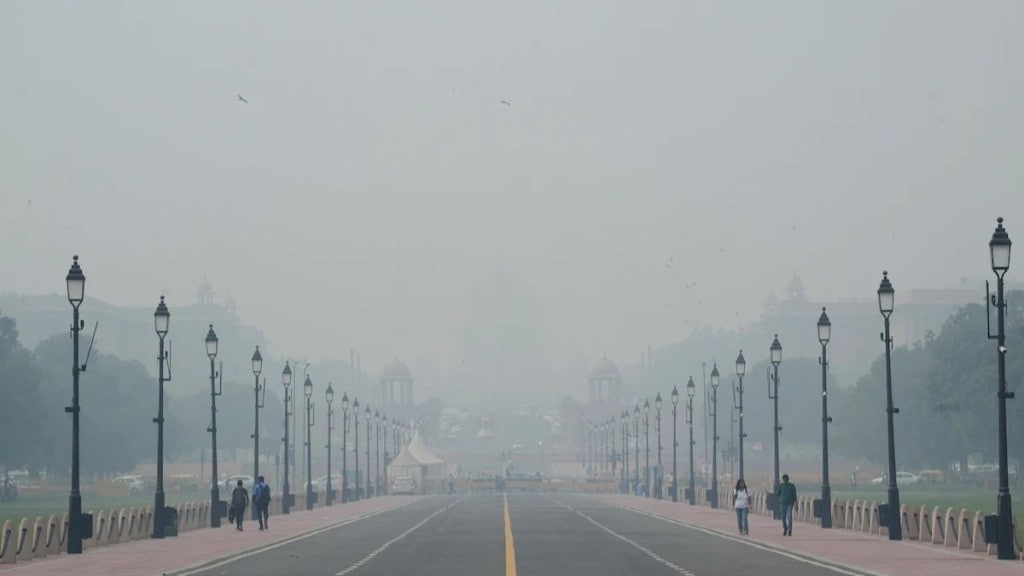With air quality in the capital still poor a week after Diwali, the Delhi government has firmed up its plans for artificial rain to tackle the capital’s pollution crisis. Banasree Purkayastha explains how cloud seeding can trigger artificial rain, and to what extent clearer skies can be expected this week
High AQI sparks talk of artificial rain
The air quality in Delhi has been hovering between the ‘poor’ to ‘very severe’ range since Diwali on October 20. On Friday, the national capital recorded an air quality index (AQI) of 293, indicating ‘poor’ quality, though some high-traffic spots recorded above-400 levels, according to the data available at the official website of the Central Pollution Control Board (CPCB). Though this is a dip from the 325 AQI recorded on Thursday and 345 on Wednesday, the extremely high levels of air pollution remains a health concern.
This has led the Delhi government to consider cloud seeding to create artificial rain as a short-term solution to wash away toxic pollutants such as PM 2.5 and PM 10. Chief Minister Rekha Gupta has indicated that cloud seeding is a “necessity” and it could carry out the experiment as early as this week.
The AQI reading is categorised as Good (0-50), Satisfactory (51-100), Moderately Polluted (101-200), Poor (201-300), Very Poor (301-400), and Severe (401-500). Higher the AQI reading, the unhealthier it is to breathe.
Cloud seeding trial carried out
Last thursday, experts from IIT Kanpur’s department of aerospace engineering, in coordination with the Delhi government, had successfully conducted a trial test in the Burari area, on the north-western fringes of the city. A trial seeding flight was conducted from IIT Kanpur to the Delhi area via Meerut, Khekra, Burari, Sadakpur, Bhojpur, Aligarh, and back to IIT Kanpur.
Cloud seeding flares were fired between Khekra and Burari and over the Badli area using pyro techniques. Following this, the Chief Minister posted on social media platform X that the weather department expects cloudy weather on October 28, 29, and 30.
“If weather continues to be good, Delhi will see its first man-made rain on October 29,” the post stated. She asserted that the project is not just “technologically historic” but also sets a “scientific method of fighting
pollution in Delhi.”
How cloud seeding works
Cloud seeding is a weather modification technique where special materials called seeding agents are added into the air to encourage clouds to produce more precipitation, resulting in increased rainfall, snowfall, or even hail. Silver iodide, potassium iodide, salt and dry ice (frozen CO2) are the seeding agents. Planes, cloud seeding aircraft, rockets, drones, or ground-based generators can release seeding agents into the cloud.
Silver iodide is most widely used as it helps ice crystals form in cold clouds. The added particles act like dust that water can cling to. As more moisture collects, the droplets grow larger, and once they become too heavy they fall as rain, snow, or hail depending on the temperature.
The process works best in existing clouds that already have some moisture. It cannot create rain out of clear blue skies. This is why the Delhi government’s plan has remained on hold for almost a week.
Can artificial rain clean up the air?
The effectiveness of cloud seeding depends on the amount of moisture in the cloud, wind and temperature conditions, the timing and type of seeding and the size of the area being seeded. Studies have shown benefits of cloud seeding ranging from a 5% to 20% increase in precipitation. While the effectiveness of this solution in the national capital is debatable, cloud seeding was first conceived in 1946 and was quickly weaponised during the Vietnam War.
Today, it is widely used in arid regions to boost precipitation artificially and is also employed to clear airport fog, fight forest fires, suppress hail, and even divert rainfall, as seen during the 2008 Beijing Olympics. China, especially, has used the technique to combat air pollution in its mega cities. Earlier this year, using a fleet of cloud seeding drones and 1 kg of silver iodide, it boosted rainfall by over 4% in Xinjiang, a dry region in western China, according to The South China Morning Post.
Why pollution levels are high in Delhi?
Delhi’s geographical location and low temperatures every winter provide the perfect environment for air pollution to reach hazardous levels. Stubble burning in neighbouring states, vehicle emissions, construction dust all add up to create a cocktail of toxic gases.While initially the air is characterised by photochemical pollutants such as ozone (O3) and carbon monoxide (CO), post-Diwali particulate matter overtakes these emissions.
The CPCB calculates AQI based on eight pollutants: PM10, PM2.5, ozone (O3), sulfur dioxide (SO2), nitrogen dioxide (NO2), carbon monoxide (CO), lead (Pb), and ammonia (NH3). The Commission for Air Quality Management’s emergency response mechanism or Graded Response Action Plan (GRAP) kicks in when the AQI reaches “poor” levels during peak pollution season, curtailing vehicular movement, construction and industrial activity, and even closure of educational institutions.

